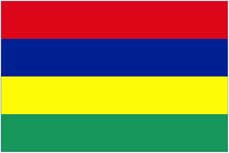-
-
- Mauritius Map
|
-
-
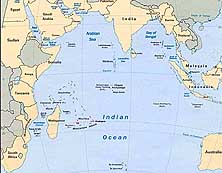
-
- Map of the Indian Ocean
|
|
-
|
- latest picture: July 16, 2011
|
-
-
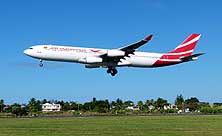
|
-
-
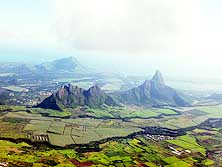
|
-
-
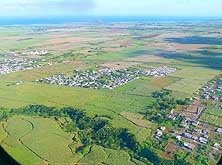
|
- 001
On June 22, 2011, Air Mauritius
- brings us in an 8 hour flight from Kuala
- Lumpur in Malaysia to the island of
- Mauritius in the Indian Ocean.
- During this flight we leave Asia for
- Africa while crossing the Equator
- from North to the South
|
- 002
Bizarre mountains rising steeply
- from the plains and sugar cane fields
- are our first impressions on our
- approach of this island that
- geographically belongs to Africa
|
- 003
Villages interrupt the green
- of the vast sugar cane fields
|
-
- Bizarre mountain groups are towering steeply between endless green sugar cane
plantations towards a blue sky. This is the surprising scenery that greets us on Air
Mauritius‘ approach to the airport Plaisance in the Southeast of the rather small
island (709 sq.mi.), lying in the middle of the Indian
Ocean. It is Wednesday, June 22nd, 2011. We end up at a talkative and smiling
immigration officer who right away stamps us a three months’ stay into our passports.
Also the customs officers look at us benevolently when we push our trolley trough the
“Green Channel - Nothing to declare“. It immediately makes us feel welcomed.
Outside of the airport our organized transport is already waiting for us and within 20
minutes we are in our booked guesthouse “Le Saladier“in Mahébourg, still close
to the airport.
|
-
-
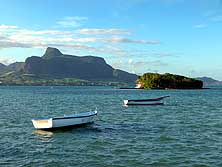
|
-
-
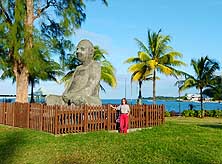
|
-
-
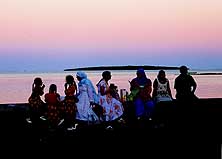
|
- 004
“Lion’s Head“in the Southeast
- is dominating Mahébourg’s waterfront.
- Once it was a busy port, today there
- are only a few fishing boats
|
- 005
Liliana is standing in front of the
- “Statue of Harmony Swami Sivandanda”
- built by young volunteers at
- Mahébourg’s waterfront
|
- 006
The sun is setting at the ocean
- front at Mahébourg. It is a favorite
- place for local families at weekends
|
-
- Already shortly afterwards we stroll along Mahébourg‘s water front where in 1680
the first fleets of the Dutch landed. On this late Wednesday evening, we almost feel a bit
“lonely“. No crowds, no noise, only a couple of anchored fishing boats bobbing
up and down, an offshore island and a striking mountain ridge, the “Lion’s
Head“ greeting from the other side of the bay. What a different picture from the one
we left behind only seven hours ago – from the hustle and bustle of Kuala Lumpur in Malaysia but also in Australasia (Southeast Asia and Pacific).
After six years and 19 new countries we swapped now with Africa. Yes, geographically, we
are in Africa again. The “real“ African life however
is still a world away. The majority of the population on the mainland is of Indian origin.
They are descendants of Indian workers imported to cultivate the sugar cane fields. But
also Chinese and Europeans made the “Pearl of the Indian
Ocean“ – how the island is also called – their permanent home.
|
-
-
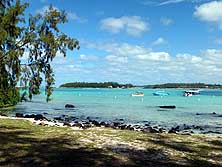
|
-
-
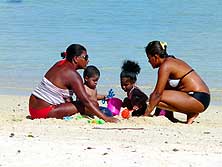
|
-
-
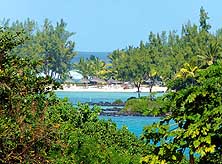
|
- 007
“Blue Bay“ in the South of Mahébourg
- deserves its name! Surrounded by white
- sandy beaches and tiny offshore islands,
- it evokes a whiff of the South Pacific …..
|
- 008
..... mothers are playing with
- their kids at the public beach
|
- 009
View over an upscale beach
- resort at “Blue Bay“ South
- of Mahébourg
|
-
- “Bonjour!“ Friendly people are greeting us. “Do they not speak English on
the island?” Soon we learn that English is recognized as the official language. In
day-to-day life however French and Creole is widely spoken, dating back to the long French
colonial time from 1710 until 1810. One more thing they have adopted from the French: The
crispy baguette freshly baked every morning and evening! Topped with a piece of tasty
French cheese, some slices of salami and one-two local “Phoenix“ beer, is always
a special treat. What more do we want? To begin with, we booked merely for three nights at
the friendly “Auberge Le Saladier“guesthouse in Mahébourg, because we knew that
afterwards we were in the air again: To the small laid-back island of Rodrigues, covering only 42 sq.mi., but lying 350 miles East
of Mauritius. It belongs politically to Mauritius – but is autonomous – and is
said to look as relaxed as the main island did 60 years ago. We are looking forward to a
quiet week until the arrival of the delayed container with our LandCruiser in Port Louis
that comes from Sri Lanka. (There is a separate webpage
about Rodrigues).
|
-
-
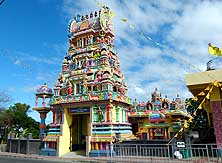
|
-
-
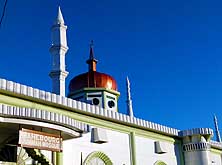
|
-
-

|
- 010
Beautiful Hindu temple in
- Mahébourg. The majority of the
- Mauritius population is Hindu
|
- 011
The Mahébourg Mosque is rising
- against a deep blue sky. There is quite
- a big Muslim community in this city
|
- 012
The Christian church “Notre Dame
- des Anges“ is the focal point of Mahébourg.
- About 52% of the Mauritians are Hindu,
- 28% Christians and 17% Muslims (Wikipedia)
|
-
- After a week of nostalgic life on Rodrigues where
“they roll the sideways up at night“ we are back on the more busy main island
and also again in the guesthouse “Le Saladier“ in Mahébourg. At 8am on Monday
morning, we are once more catching the local bus to Port Louis that is passing by only a
few steps away from where we stay and conveniently just can be stopped along the road.
There are still enough free seats. But soon it fills up on the two-hour-drive across the
island to the capital 30 miles away. Then it means standing for those who board later.
Going this way daily to work in the morning is rather uncomfortable. For us, our container
is calling. It has been unloaded in the port last Friday. Now we need to take care of the
compulsory insurance and the local visitor license plate.
|
-
-
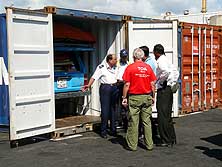
|
-
-
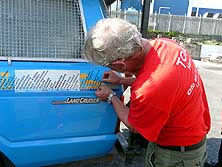
|
-
-
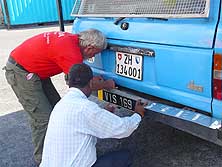
|
- 013
July 7, 2011: Our container is
- opened in the port of Port Louis in the
- presence of the head of the customs
- and other staff. Our LandCruiser was
- loaded on May 25, 2011, in Sri Lanka
- and reached Mauritius via Malaysia
- and Réunion
|
- 014
Emil is adding the “Mauritius sticker”
- at the country band of our LandCruiser.
- Mauritius is our 170th visited country on
- our almost 27th years lasting epic
- journey around the world
|
- 015
With the help of our agent, Emil
- attaches the temporary local license
- plate “VIS 169“ at our LandCruiser
|
-
- Just short of Port Louis we ask the friendly looking ticket collector, who goes from
seat to seat to cash the fare of 35 Rupees (= US$ 1.20) per person, to give us a sign when
we have to get off for the NTA , the National Transport Authority. “On our return
journey we can drop you right in front of it” he offers. What a kind gesture! Because
we have started already with the car’s paper work before we flew to Rodrigues, things
go more or less smoothly. In less than half an hour, we leave the crowded building with
the license plate No. VIS 169 and Rp. 4‘500 (= US$ 155) less in our pocket (Rp.
3‘000 is the deposit for the license plates and Rp. 1‘500 for the monthly road
tax). Also with the agent of the Whitegate Insurance Company we soon reach an agreement
for the mandatory third party insurance, but only next day. However we must pay the
premium for a whole year (Rp. 8‘400 = US$ 288) with the prospect of reimbursement of
the too many paid months at our departure. To come straight to the point: It worked out
for both, but the refund has taken four months for the number plates!
|
-
-
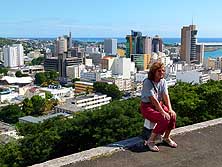
|
-
-
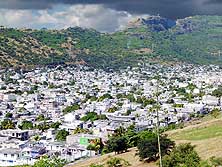
|
-
-
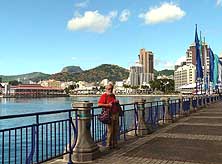
|
- 016
View from Fort Adelaide over
- the city center of Port Louis. The citadel
- has been built by the British but was
- never used as a Fortress
|
- 017
The sea of houses of Port Louis
- is spreading towards the surrounding
- hills. There are about 160’000 people
- living in the capital of Mauritius
|
- 018
The appealing “Caudan”
- Waterfront in Port Louis invites to
- shop, stroll or just take a break
|
-
- Exploring this lively capital with a population of around 160‘000 people is full of
surprises. It is a mixture of modern and ancient, of capital and village character, of
teeming local and “orderly“ touristic life. Our favorits are the lovely
“Boulevard Place d’Armes“, lined by majestic royal palms and compared a bit
with Champs-Élysées in Paris and the snow-white Jummah Mosque with its playful turrets.
But also the small market hall, built in the colonial style, sitting a bit lost between
modern highrise skyscrapers, attracts always our eyes.
|
-
-
-
-
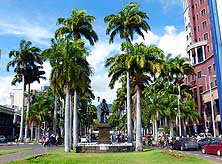
|
-
-
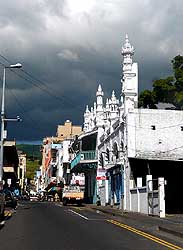
|
-
-
-
-
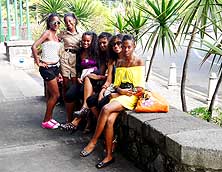
|
- 019
The “Boulevard Place d’Armes“
- in Port Louis is lined with majestic royal
- palms and is compared with Champs-
- Elysees in Paris
|
- 020
The white turrets of Port
- Louis’ Yuma (Jummah) Mosque
- rise against a stormy sky
|
- 021
Mauritius beauties gather at
- the Caudan waterfront in the
- center of Port Louis
|
-
- The lively colorful market scenes with the many street vendors are omnipresent. We
prefer this compared to the modern “Caudan Waterfront“ with its smart
restaurants, expensive shops and a casino, despite that is a lovely place to stroll and
relax. There we see also most of the mostly short term tourists. Of course we drive also
up the hill to Fort Adelaide where the compact city with the white sea of houses spreading
towards the surrounding hills lies to our feet. The citadel was built by the English, but
it was never used as a fortress.
|
-
-
-
-
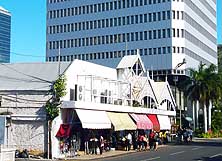
|
-
-
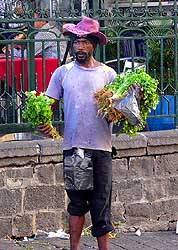
|
-
-
-
-
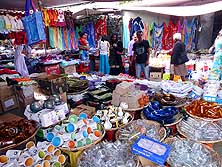
|
- 022
Port Louis‘market place is sticking out
- pleasantly against the modern skyscraper
|
- 023
A street vendor tries to
- find a buyer for his vegetable
|
- 024
A market corner in Port Louis
- cramped with all kind of house ware
|
-
- Finally Wednesday is the day: Full of expectations, we are waiting in front of our
container to be opened. The first thing we notice is that our personal padlock we fixed in
Colombo on Sri Lanka is missing. Then we also see that the
seal does not have its original number – a clear proof that the container was
reopened somewhere: Either still in Sri Lanka or in Malaysia
or Réunion, the two transshipment ports. But this does not
really worry us much, because it is not the first time. It was already the case at the
arrival in Papua New Guinea, coming from Jakarta/Indonesia. However, in such a case we don’t take over
anymore the responsibility for the container’s content, because not only something
might be missing, just as well something else could have been added.
|
-
-
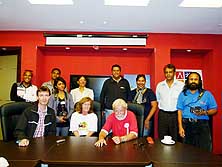
|
-
-
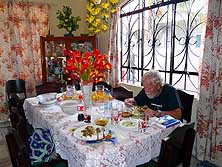
|
-
-
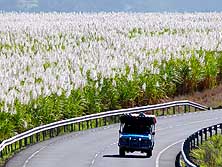
|
- 025
Journalists and TV crew pose
- for a picture after the press conference
- at the Tourist Promotion Authority in
- Port Louis. Behind Liliana is Mrs.
- Roselyne Hauchler who arranged a
- bond free entrance of our LandCruiser
|
- 026
At a family restaurant in
- Port Louis, our Beef Curry is
- served in the private living room
|
- 027
Finally “on the road again”! We
- drive through endless sugar cane fields
- whose “flowers” are shining
- beautifully in the evening sun
|
-
- But here it becomes suddenly a problem: CMA-CGM – the shipping line – has its
own rules in such a case: It has to investigate about it. Where did it happen and by whom?
Only after clarification and after the headquarters in Marseille have given their
approval, the container may be opened. We do not dare to think how long that may take! For
now it means in the first place that we will have to leave the port without our treasured
companion and sit again for two hours in the bus until we are “home“ in
Mahébourg on the opposite side of the island. At least the scenery we pass is really
beautiful and the bizarre mountain peaks that rise straight from the plains are always a
lovely sight.
|
-
-
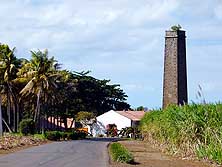
|
-
-
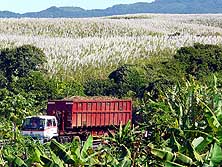
|
-
-
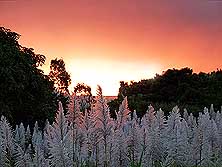
|
- 028
Chimneys of the ancient sugar
- cane mills are still dotting the landscape.
- Annually 600’000 tons of sugar are
- produced in the average; 530’000 tons
- are exported to the European Union
|
- 029
The sugar cane harvest is in
- full swing. Highly and heavely
- loaded trucks are on the road
|
- 030
The sun is setting behind
- a sugar cane field
|
-
- Wonders will never cease: Because next morning, July 7th, 2011, at 11am, we are already
standing once more in front of our container. Yesterday we put a lot of pressure on
CMA-CGM. They pulled out all the stops and apparently got the approval from Marseille
before the office closed, when it became clear that our container was reopened by the
customs authorities of Colombo in Sri Lanka (presumably due
to container scanning). Now, finally the seal is broken, under the eyes of at least a
dozen people. They are from the customs, from the port, from the shipping line and from
the agency. Of course, now everybody is anxious and curious to see what might have changed
in that box.
|
-
-
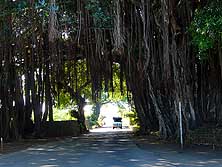
|
-
-
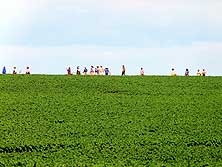
|
-
-
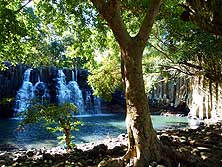
|
- 031
Our LandCruiser drives towards
- a small “alley” of deep hanging roots
- on the Southeastern coastal
- road near Savannah
|
- 032
Teatime: Workers of a potato
- field walk along the edge of a field
|
- 033
The Rochester Falls near Souillac
- in the South are gushing into a small
- pond, surrounded by trees. The name
- “Rochester” was given during the
- period of 1847 when the novel “Jane
- Eyre” by Charlotte Brontë, with the
- main character “Mr. Rochester”
- was published
|
-
- There is fortunately no sensation – it is our good old blue LandCruiser – our
indispensable travel buddy. Nothing is missing, nothing is „added“; it stands in
front of us safe and sound as we drove it in 44 days ago; the broken original seal lies in
a corner. As always, it arouses immediately a lot of admiration and the customs’
check is no longer an issue. What a wonderful feeling to be mobile and independent again
and to be able to discover our 170th country! There is still left one obligation however:
The press conference in the afternoon, organized by the Ministry of Tourism. Here we
cannot dodge because it is only and alone their merit – especially Ms.
Hauchler’s – that in the last minute a bond-free entry of our car has been
granted.
|
-
-

|
-
-
-
-
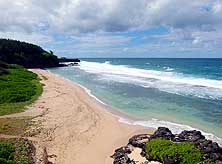
|
-
-
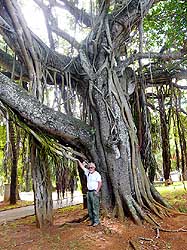
|
- 034
The black rocky coastline near
- Souillac’s Gris-Gris beach in the
- South is known for its strong waves
|
- 035
Though the small Gris-Gris beach
- near Souillac in the South looks inviting,
- swimming is not recommended due to
- the strong current
|
- 036
Emil is standing in front of
- impressing tree roots at the sea
- shore park of Souillac in the South
|
-
- Due to our published article in the newspapers, locals approach us already next day when
we are walking along the white sandy beach at Blue Bay that is hardly a five minutes drive
to the South from Mahébourg. It is a scenery like in a picture book: The blue lagoon, the
glistening white sandy beach and some tiny off shore islands evoke a whiff of a South Pacific flair. No wonder that it is also very
touristy and no wonder that there are plenty of persistent touts and hawkers, which is
annoying after a while.
|
-
-
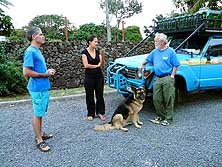
|
-
-
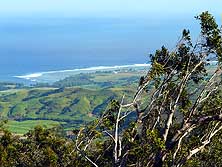
|
-
-
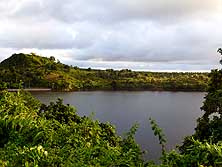
|
- 037
Emil chats with Wynette and James
- who invited us to a barbecue to their
- house in Mont Désert near Plaisance.
- Both are enthusiastic travelers too
|
- 038
Looking down from the nearly
- 2’300 ft. high Black River
- National Park to the South Coast
|
- 039
The “Grand Bassin” Craterlake
- (Ganga Talao) in the Southern Highlands
- is a sacred pilgrimage place to the
- big Hindu community
|
-
- It begins usually with a little small talk, but does not take long before they try to
sell something, be it a boat trip, a souvenir or another trap. All the more we are pleased
to meet Wynette, James and their son Matthew. Immediately we have an interesting
conversation and already two days later we are sitting in their lovely home bordering a
sugar cane field sipping a glass of wine. Wynette is from South Africa and James from
Zambia and a helicopter pilot at Air Mauritius. Both are enthusiastic travelers. They are
living already since five years in Mauritius and James just renewed his contract for
another ten years. They like the life on the island.
|
-
-
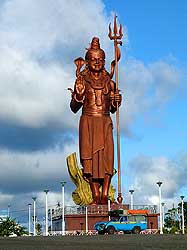
|
-
-
-
-
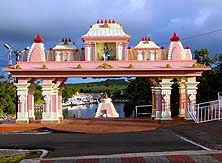
|
-
-

|
- 040
The bronze statue of the Hindu God
- Shiva is standing guard to the holy “Ganga
- Talao”. With 108 feet, it is the tallest statue
- in Mauritius. Wrapped around his arms
- and shoulders are three cobras …..
|
- 041
….. The view through the temple
- gate to the „Ganga Talao“ with the
- temple on the other lake side
- is simply stunning …..
|
- 042
.....The silhouette of the
- Hindu God Shiva against the
- darkening evening sky
|
-
- It‘s ages since we were able to chat with like-minded people, having spent the past
years mainly on islands “off the beaten track“ of “ordinary” car
travelers. Somehow we are missing this exchange of experiences. It is James who tries to
dispel our doubts not to wild camp on beaches for safety reasons, where there are often
toilets and even cold showers. But he is and remains the only person who doesn’t see
any security issue. Otherwise we are always warned about it. Whom do we have to believe
now? Therefore we prefer to play safe and keep our guesthouse “Le Saladier“ in
Mahébourg as a base for the discovery of the small island where returning the same day is
no question at all. We like it in the guesthouse, as we have two rooms and wifi and a
complete kitchen that nobody else is using and our LandCruiser has a safe parking in the
garage. But for US$ 55 a night, including breakfast, it is still a luxury for a place we
call temporarily our home!
|
-
-
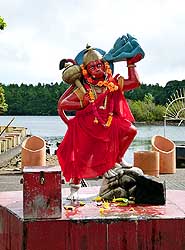
|
-
-
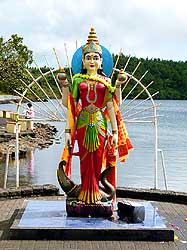
|
-
-
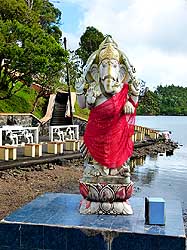
|
- “Ganga Talao” is a famous pilgrimage site for the approximately 500’000
Hindu population of Mauritius. Every year, at Maha Shivaratri
- festival in February/March, devotees from all over the island make the pilgrimage to the
lake bare footed to make offerings to their gods
|
- 043
to Hanuman
|
- 044
to Lord Vishnu
|
- 045
to Ganesh
|
-
- It is wintertime in Mauritius and therefore off-season. The skies are deep blue, the air
is fresh and the sight is clear when we start to our first tour along the Eastern shore of
the Southern half. Emerald-green fields of sugar cane spread endlessly in front of us.
Sometimes its flowers are glistening white, sometimes silvery, then brown, then pink
– depending on the incident sunlight. They are flowering between May and October. Now
and then a high chimney of an ancient sugar cane mill arises. The cane is cut 80%
mechanically, 20% still by hand – where the topography doesn’t allow it. Until
five years ago 600‘000 metric tons of sugar were produced annually. 530‘000 tons
were exported to the European Union. Business was not anymore that profitable when the
sugar prices dropped by 20%. Today’s main income is tourism and textile.
|
-
-
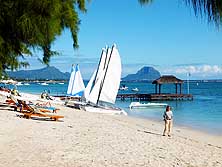
|
-
-
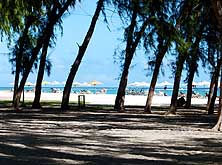
|
-
-
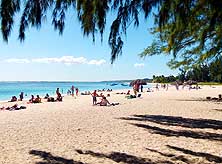
|
- 046
Flic-en-Flac in the West is a
- famous tourist center. Top-end resorts
- are side by side. Here at the Hilton
- beach that borders the public beach …..
|
- 047
….. its umbrellas are
- arranged perfectly in a line …..
|
- 048
….. no chairs, no umbrellas – the
- public beach, sandwiched between
- Hotel Resorts. However there are many
- public beaches around Mauritius, which
- are accessible to everybody for free
|
-
- East of Souillac on the South coast we branch off to the Gris-Gris-Beach. It is a rocky
coast line with a small sandy beach and a strong current. There are even picnic tables,
benches and rubbish bins! Later, West of Souillac, we follow a rusty small road sign, half
hidden by high sugar cane, to the Rochester water falls, named after the main character of
the novel “Jane Eyre“ of Charlotte Bronte, published around 1847. Are we on the
right path? – we suddenly doubt, when we drive for a long time through a narrow cane
“tunnel“. It ends abruptly at a little open grassy space. We park our
LandCruiser and continue on foot. Soon we hear the rushing of the water fall and reaching
it, we feel a wonderful aura of peace. The sun is just seeping through the foliage of the
high trees and illuminates the twin waterfall that is rushing into a small pool. It is not
spectacular, but lovely in its natural environment. The only disturbing factor is a bunch
of shouting juveniles gathering up the falls ready to jump into the pool for some money.
|
-
-
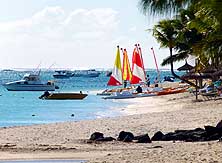
|
-
-
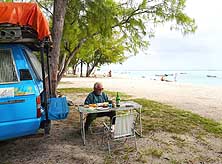
|
-
-
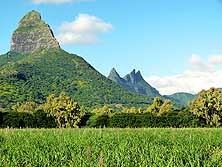
|
- 049
Water sport is not lacking in
- Flic-en-Flac. There is a big
- competition at the high-end resorts
|
- 050
Our picnic consisting of baguette,
- salami, cheese, olives and local Phoenix
- beer takes place under casuarinas at
- Flic-en-Flac’s public beach
|
- 051
Inland, South of Flic-en-Flac, the
- mountain peaks of the “Montagne du
- Rempart” (left) and the three “Mamelles”
- tower almost vertically against the sky
|
-
- A few miles further we are at another sandy beach, ideal for our lunch picnic. How
different it is here compared with overcrowded Asia: No curious
people showing up and staring for hours – our privacy is respected. With each day, we
like Mauritius more! In the meantime, it is mid-afternoon and according to Lonely Planet
we are approaching the most attractive coastline of the entire island: Morne Brabant in
the Southwest. We definitively want to save this jewel for another day. Today we actually
only want to make a loop, otherwise we have explored the whole island already in a couple
of days, which is definitively too fast. We need to amortize the freight and hefty port
fees on a longer term.
|
-
-
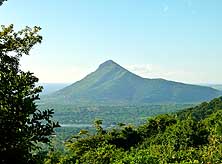
|
-
-
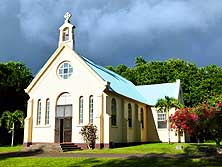
|
-
-
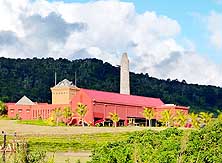
|
- 052
View towards the “Piton Canot”
- from the Western access road to the
- Black River Gorges National Park
|
- 053
The Chapel of Saint Anne in
- Chamarel, lying at 1’000ft. altitude
- in the Southwestern hills shines
- in the afternoon sun
|
- 054
A rum distillery in Mauritius:
- The „Rhumerie de Chamarel“
- sitting in the fertile Chamarel
- Valley in the Southwest
|
-
- Our return trip leads us at a quick pace through the Southern Highlands past the
“Black River National Park“. There, on 2’300 ft. altitude, a stiff wind is
blowing. Since a very long time we grab our warm jumpers. Evening is approaching and the
sun sits already low when near the National Park entry suddenly a huge bronze statue
towers in front of us, glistening in the evening light. We are totally taken by surprise
at this beautiful sight and read that it represents the Hindu God Shiva that is a standing
guard to the holy “Ganga Talao“ crater lake and its lakeshore temple. With 108
feet height, it is the tallest statue in Mauritius. Wrapped around its arms and shoulders
are three cobras. “Ganga Talao“ is an important pilgrimage site for the Hindu
community, which counts about 500‘000 heads. At the annual “Maha Shivaratri
Festival” in February/March devotees from all over the island go barefooted on a
pilgrimage to the temple to make offerings to their gods.
|
-
-
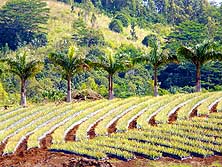
|
-
-
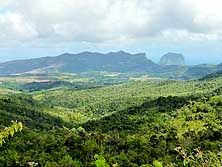
|
-
-
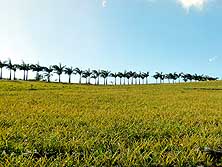
|
- 055
The mild climate of the fertile
- Chamarel Valley favors also the
- pineapple growth
|
- 056
View over the gentle Western
- hills from the Black River Gorges National
- Park towards the South. The block in
- the back at right is the “Morne Brabant”
|
- 057
Swaying palm trees border
- a pineapple field in the Chamarel
- Valley in the Southwest
|
-
- The scent of freshly brewed coffee from the breakfast room lies in the air. On the
terrace the flock of birds that come every morning is already present, waiting for our
breakfast breadcrumbs: The cheeky Madagascan Red Fody with its distinctive call, three shy
Red-Whiskered BulBul and two gentle grey pigeons. It is a peaceful start of a new day. The
blue skies are promising and we start to our second trip to the South of the island.
Through the fertile Chamaral Valley we cross the Southern Highlands from East to the West
where sweet pineapples are growing, favored by the mild climate of this region. We cannot
miss the viewpoint at the “Black River Gorges National Park” on 2’300 ft.
altitude. Souvenir shops line the path to the lookout. From there, we enjoy a sweeping
view over rolling hills gleaming in the sun and a small waterfall cascading almost
vertically through all shades of jungle green.
|
-
-
-
-
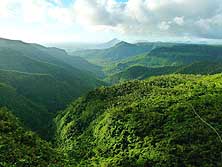
|
-
-
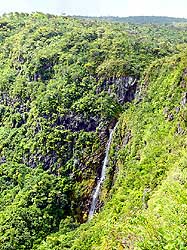
|
-
-
-
-
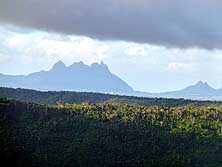
|
- 058
View Northwards from the
- lookout of the Black River Gorges
- National Park over the rolling hills …..
|
- 059
..... and the waterfall
- cascading almost vertically
- through dense vegetation
|
- 060
The skies darken over the “Pieter
- Both” Mountain, with 2’690ft. the
- second highest mountain in Mauritius
|
-
- After our descent to the valley, we roll towards the most famous beach resort in the
Southwest – “Flip en Flac“ with shining white sandy beaches, lined by
casuarinas, and a turquoise lagoon. On one side one hotel complex of the luxury class
after the other lines the beach with all its amenities – from beach chairs, parasols
to all kind of water sports. On the other side is the public beach with clean sanitary
facilities and cold showers what we learn to appreciate later on most of the beaches.
Where else in the world are there still such beautiful well equipped free beaches, most of
them even with car access right to the shore? This is our world! Here we enjoy our picnic
before we continue our tour through the South of the island.
|
-
-
-
-
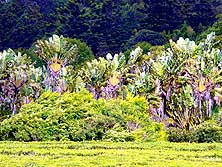
|
-
-
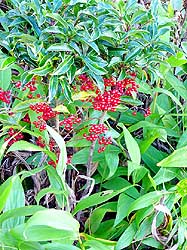
|
-
-
-
-
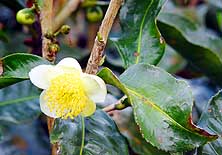
|
- 061
The sun catches the fan-shaped
- „voyageurs“. This plant from the family
- of Strelitziaceae grows more than 30ft.
- and collects water what gave it the
- name „traveler’s tree“ (Ravenala
- madagascariensis). Although there
- are forests of it in Mauritius, it is
- originating from Madagascar
|
- 062
The red berry of the
- “Brazilian Pepper“ (Schinus
- terebinthifolius) contrast to the
- luxuriant green of the highland.
- It is not a true pepper but is
- also used as a spice, often
- together with real pepper
|
- 063
The delicate flower of the tea
- plant. The tea plantations in Mauritius
- cannot be compared to those in
- Sri Lanka or Malaysia. They
are found
- only at an altitude of around 1’600ft.
- and are rather small-area
|
-
|
| More websites
from Mauritius:
|
-
- Articles in newspapers about us in Mauritius:
- Article: "Le tour du monde en LandCruiser",
Daily Newspaper "Le Mauricien" - July 9, 2011
- Article: "Globe lovers",
Weekly Newspaper "Le Dimanche" - July 10, 2011
- Article: "Emil
et Liliana Schmid sur les routes à Maurice", Daily Newspaper "Le
Matinal" - July 12, 2011
|
![]()


